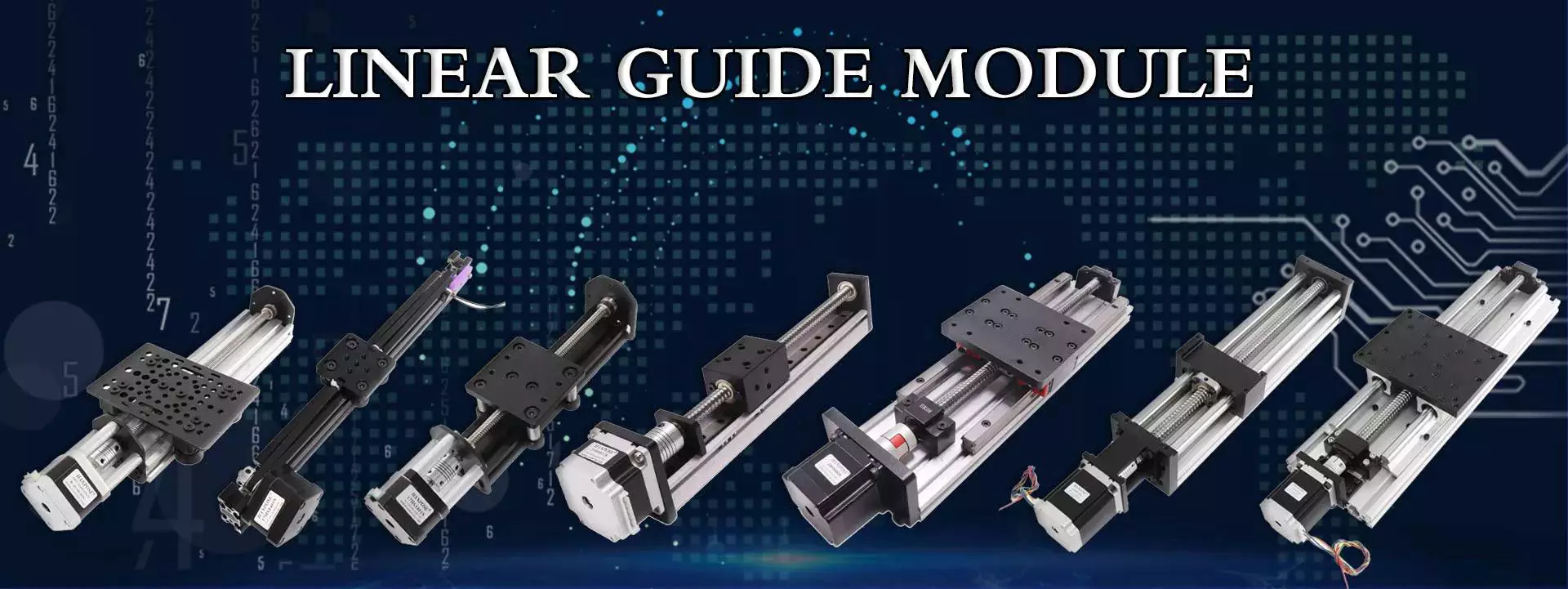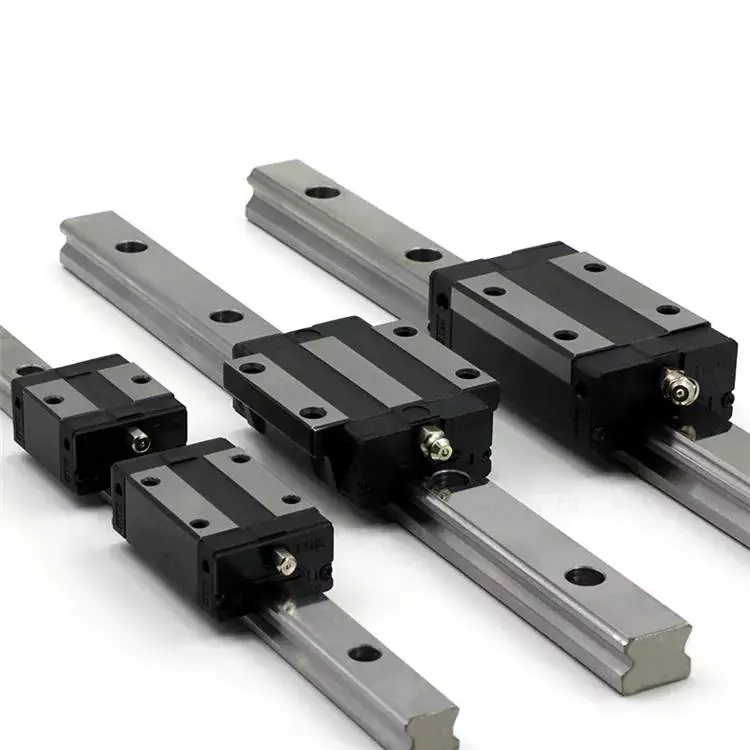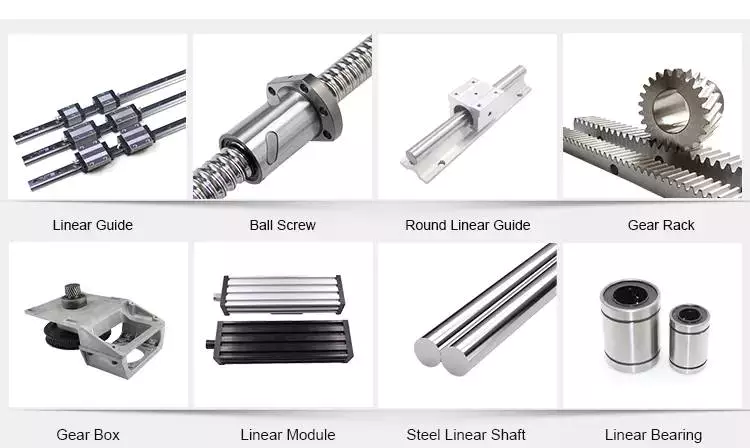Product Description
I have all the models you need, these are just some of them, please contact us now
HG Series
Basic Dynamic Load Range: 11.38 kN – 208.36 kN
The HG series linear guideways are designed with load capacity and rigidity higher than other similar products with circular-arc groove and structure optimization. It features equal load ratings in the radial, reverse radial and lateral directions, and self-aligning to absorb installation-error. Thus, the HG series linear guideways can achieve a long life with high speed, high accuracy and smooth linear motion.
EG Series
Basic Dynamic Load Range: 5.35 kN – 33.35 kN
The EG series is a low profile, high load capacity, and high rigidity guideway block. It also features an equal load rating in all 4 directions and self-aligning capability to absorb installation-error, allowing for higher accuracies. Additionally, the lower assembly height and the shorter length make the EG series more suitable for high-speed, automation machines and applications where space is limited.
CG Series
Superior Moment Load Capacity
The CG series linear guideways have moment load capacities up to 50% higher than standard HG Assemblies. The O-Type (back-to-back) bearing configuration and an integrated recirculation unit optimize bearing circulation greatly improving moment load capacities and promoting smooth motion. An optional stainless steel cover strip increases dust protection and promotes smooth block transition.
RG Series
Basic Dynamic Load Range: 11.3 kN – 275.3 kN
The RG series features a roller as the rolling element instead of steel balls. The RG series is designed with a 45-degree angle of contact. Elastic deformation of the linear contact surface, during loading, is greatly reduced thereby offering greater rigidity and higher load capacities in all 4 load directions. The RG series linear guideway offers high performance for high-precision manufacturing and can achieve a longer service life than traditional ball bearing linear guideways.
WE Series
Basic Dynamic Load Range: 5.23kN – 29.8 kN
The WE series features equal load ratings in the radial, reverse radial and the lateral direction with contact points at 45 degrees. This along with the wide rail, allows the guideway to be rated for high loads, moments and rigidity. By design, it has a self-aligning capability that can absorb most installation errors and can meet high accuracy standards. The ability to use a single rail and to have the low profile with a low center of gravity is ideal where space is limited and/or high moments are required.
MG Series
Basic Dynamic Load Range: 0.68 kN – 8.93 kN
The MG series is a miniature linear guideway that comes in a compact size with a Gothic CZPT contact design that offers high stiffness and high rigidity against moment loads in all directions. The MG series also offers anti-corrosion protection which all material is in a special grade of stainless steel for compatibility in various working environments. The MG series is available in a narrow block type (MGN) and also with an enlarged width (MGW).
QH Series
Basic Dynamic Load Range: 13.88kN – 108.72 kN
The development of Hiwin’s QH linear guideway is based on a four-row circular-arc contact. The QH series linear guideway with SynchMotion Technology offers smooth movement, superior lubrication, quieter operation and longer running life. Therefore the QH linear guideway has broad industrial applicability in the high-tech industry where high speed, low noise, and reduced dust generation is required. The QH series is interchangeable with the HG series.
QE Series
Basic Dynamic Load Range: 8.56 kN – 51.18 kN
The development of the Hiwin’s QE linear guideway is based on a four-row circular-arc contact. The QE series linear guideway with SynchMotion Technology offers smooth movement, superior lubrication, quieter operation and longer running life. Therefore the QE linear guideway has broad industrial applicability in the high-tech industry where high speed, low noise, and reduced dust generation is required. The QE series is interchangeable with the EG series.
QW Series
Basic Dynamic Load Range: 16 kN – 36.8 kN
The QW series linear guideway with SynchMotion Technology possesses all the advantages of the WE series, which features high moment rigidity and is suitable for single rail or space saving applications. With the SynchMotion technology it also provides quieter and smoother movement, superior lubrication, and longer service life. The QW series is interchangeable with the WE series.
QR Series
Basic Dynamic Load Range: 26.3 kN – 150.8 kN
QR series offers super high rigidity and very high load capacities. The QR series with SynchMotion Technology offers low friction, smooth movement, quieter operation and longer running life. In industries where high accuracy, low noise and high rigidity are required, the QR series is the ideal guideway choice. The QR series is interchangeable with the RG series.
PG Series
positioning guideway system integrates a linear guideway with a magnetic encoder. This solution offers the high stiffness and rigidity of a guideway while obtaining high precision from the magnetic encoder. The encoder is a non-contact measuring sensor and the magnetic strip is embedded to prevent possible damage caused from external materials, these features ensure a longer service life.
| Application: | Warehouse Crane, Shipboard Crane, Goods Yard Crane, Building Crane, Workshop Crane |
|---|---|
| Material: | Aluminium |
| Structure: | Hook Crane |
| Installation: | Special Crane |
| Driven Type: | AC |
| Carrying Capacity: | Light Level |
| Samples: |
US$ 0.1/Piece
1 Piece(Min.Order) | |
|---|
| Customization: |
Available
| Customized Request |
|---|

Choosing a Linear Rail
Whether you are using a linear rail for your business or home, you will find that there are some key considerations that you must keep in mind. These include the stability and accuracy of the system, as well as the cost of the rail.
Cost of linear rails
Choosing the right rail can be crucial to the performance and cost of a machine. There are many different types, with different levels of accuracy, load bearing capacity and rigidity. Some of the more common choices are drilled, profiled and undrilled.
The cost of linear rails can vary drastically depending on the type. Some are made from hardened steel, while others are fabricated from aluminum extrusions. Both types offer different advantages and disadvantages.
Rails that have been manufactured with aluminum extrusions will offer better rigidity. These rails also provide a larger range of motion.
Linear rails are generally used in mechanical systems that need high precision. These components must be fully supported and protected while being assembled. The assembly process is complex and time consuming.
These components are used in a wide variety of industrial applications. They can be used for transporting loads between two points or for guiding a moving part in linear motion.
Linear rails are usually manufactured from hardened steel, which is corrosion-resistant. Stainless steel is also commonly used. High-strength steel is also used. It is also known as cold drawn steel.
Rails have a high load bearing capacity and can handle loads from a few grams to a few tons. They offer smooth motion and can also be used to support overhung loads. Linear rails are generally used in automation machinery. They are also used in laser welding machines and bending machines.
Stiffness
Using a linear rail is a common solution for many industrial applications. These linear guides are known for their rigidity and load-bearing capabilities. They are designed to accommodate a wide variety of uses, including precision motion, high load capacities, and high speed operation.
These linear guides are available in various sizes and shapes, including cylindrical rollers, spherical balls, and race profiles. Each type offers different load capacities, speeds, and accuracy levels. They are typically used in applications that require precision, such as machine tools.
They are typically fixed at the ends. They are designed to transfer weights along a predetermined vertical or horizontal course. Linear rails are usually made of toughened steel. They require hex slot screws along the length of the rail. They are also used to guide actuators driven by screws or belts.
These linear guides are designed to offer high travel accuracy, which is important for many machine tools. They also offer high rigidity, which is needed to support heavy loads.
The stiffness of a linear rail is generally higher than that of a round rail. They can handle travel speeds up to 5 meters per second. They can support thousands of kilograms. They are also less likely to bend under heavy load, which can prevent misalignment problems.
Linear guides are often used in pneumatic-driven systems. They also have a rolling-friction operation mode. This reduces friction, which helps the machine tool to run smoothly.
Accuracy
Choosing the best linear rail depends on the application and the level of accuracy required. Some applications require high accuracy, while others are less demanding. A guide rail that has the right amount of preloading can minimize the effect of misalignment and sinking.
Rails are designed to withstand a variety of loads from a few grams to several tons. They can also handle moment and lift-off loads. Linear rails are made from high-strength steel that is galvanized.
A variety of processing methods are used to manufacture rails. Rails are available in square and round shapes. They can also be shaped to fit into smaller spaces.
The most accurate linear rail is the one that meets all of the above requirements. It can be difficult to know which rail is best for your application. It is important to consider the application and the total load conditions during the lifetime of the system.
It is also important to choose the most appropriate accuracy class for your application. Choosing the accuracy class of a rail is partially dependent on the positioning of the load and the mounting arrangement of the bearings.
For instance, the best accuracy class for a rail would be one that has a high preloading rate. This will increase the rigidity and minimize the effect of sinking. It will also increase the life of the component.
A linear rail that has a high preloading rate also has a higher accuracy class. This is because it will compensate for a lack of accuracy in the mounting surface.
Stability
Whether you’re moving items through a production process or handling heavy loads, you’ll appreciate the reliability and precision of a linear rail. It’s also important to consider the stability of your linear rail.
It’s important to design your linear rail with a complete support structure to prevent deflection. This may include mounting it on an I-beam support. This supports heavy loads and eliminates deflection concerns.
Linear rails also offer a wide range of motion, including the ability to support overhung loads. They are also suitable for guiding weights, providing a smooth motion in a single axis.
A single linear rail can also be used to guide actuators driven by screws or belts. These are commonly used in industrial applications. However, they may not be ideal for consumer applications.
For a more robust solution, you may consider using a dual rail. Dual linear rails maximize bearing life, and minimize deflection. These can also be anchored to aluminum extrusion profiles to improve stiffness.
Various types of materials can have a dramatic impact on the cost and performance of a project. These include stainless steel, which is corrosion-resistant and cold drawn. Other options include aluminum extrusion profiles and cylinders, which can reduce mechanical stresses.
In addition, the level of stiffness of your rail may be critical to its operation. In some applications, a rail may have to flex slightly in one plane. Using a cylinder instead of a sphere can also reduce play.
Sliding carriage and rail
Known for their rigidity and load-bearing capabilities, linear slides are ideal for applications that require repeatable motion. However, these units have a variety of components that can complicate their integration into your machine. Fortunately, there are a variety of products available that can help you find the right slide.
The main components of a linear slide include the carriage, bearings, guide rails, and control systems. The bearing system determines the accuracy of the slide.
Bearings can be a variety of shapes, including cylindrical and ball. They can be plain or filled with PTFE, ceramic, or metal. A ball screw drive with a motor may be necessary for stiff, reproducible slides. In less expensive applications, a round shaft system may be the best option.
Typically, the carriage is attached to the rail. The rail supports the carriage while it moves, and it can be a round rail, profiled rail, or linear stage. The carriage can be made of stainless steel, aluminum, granite, or other materials. Its threaded holes can be used for mounting tooling.
Carriage designs can be based on plain bearings, ball bearings, or cross rollers. Aside from simple surface bearings, these designs require lubrication. In less expensive applications, plain bearings may be sufficient.
Roller bearings are cylindrical roller load-bearing elements. They are used in track rollers and cam rollers. The rollers are inside the carriage and rotate with the carriage.
Applications
Whether you’re building an industrial automation system or simply need to move a load, the right linear guide can be a valuable tool. The benefits include high load capacity, reduced friction, high rigidity and increased accuracy.
The applications of linear rails can range from simple machine-tool applications to advanced medical applications. The most common applications include transportation and industrial machinery. However, the applications can also be found in the consumer space. Consumer health monitoring devices are a great example of applications that take advantage of linear motion.
Linear rails are a linear assembly consisting of load-supporting balls on each side and a pair of parallel tracks. Depending on the size and type of application, the load capacity can range from a few grams to several tons.
Linear rails are typically made from high-strength steel, which is profiled or galvanised. The rail is then cut to a specified length. Depending on the size, the cost of a linear guide rail will vary.
The linear rail’s name is a mouthful, but there are several models to choose from. Profiled rail guides are most suitable for high load applications.
The CZPT is a great choice for heavy-duty applications. It’s easily weldable, and can be ground smooth for easy transitions. The rail can be extended to long travel lengths.
The linear rail’s most notable attribute is its ability to withstand overhung loads. The rail can also handle moment and horizontal loads.

editor by CX 2023-04-23